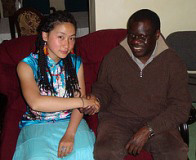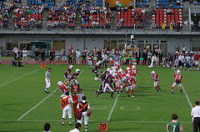GETTING INTERNATIONAL.- Culture and people. Cultural differences and stereotypes.
Read the text and listen to the recording.

Is it polite to shake hands in China, or to smoke in a business meeting in Australia? Let's take a minute to stop and think about cultural differences.
When working with people from different countries, you have to understand and respect cultural diversity: the differences between regions, countries and cultures. You have to learn the skills of proper etiquette, manners, and intercultural communication.
First of all, when people go into another cultural environment, some of the things that can be different for them are such things as the verbal communication style, that can be radically different. And we're not just talking about a different language but literally the way that we use verbal communication.
Secondly, the non-verbal communication, body language, the gestures and the things that we do as part of our communication. For example, when you greet someone, body contact is generally taboo in most Asian countries but in other parts of the world hugging and kissing is acceptable. Even within France, some people kiss on one cheek only, some on two cheeks, some on three cheeks.
Another good example of cultural difference is in the way different cultures view time. Do we see time as a linear process with a fixed series of events following each other, or is time something much looser, much more flexible? People have different attitudes to time and experience time in different ways. Westerners feel that Easterners are rude when they come 20 minutes to half an hour late to an appointment. But when an Easterner says "11:00" he or she means "between 11 and 12". In contrast Westerners divide time into strictly-measured hours, minutes and seconds, into which one carefully arranges one's plans, appointments, and activities so as to fit exactly and not cause delays to one's own or anyone else's plans. When persons with different assumptions come into contact there is great room for misunderstanding!
You have to be very careful with stereotypes. A national stereotype is a system of culture-specific beliefs connected with the nationality of a person. This system includes beliefs concerning those properties of human beings that may vary across nations, such as appearance, language, food, habits, psychological traits, attitudes, values etc. When we stereotype someone, we assume that they will behave in a certain way. Don't stereotype people from other nationalities. Keep an open mind and remember that we all are individuals.
Activity adapted from http://www.kwintessential.co.uk/resources/country-profiles.html
Decide if the following are true or false:
In Japan you can introduce yourself if you are attending a large meeting.

1.- Experiences of people living abroad.
If you were an exchange student in a different country, which cultural differences do you think would affect you the most? Which would you enjoy and which would bother you?
What cultural differences would exchange students in your country have trouble with? Which cultural differences might they enjoy?
We are going to watch a video in which some exchange students talk about some of the quirky differences between their homelands and the United States.

| Topic | Match | Speaker |
|---|---|---|
| There's a lot of school spirit in America. | 1. Student 1 (boy from Spain). | |
| Stuff is big in America. | ||
| A lot of food has peanut butter in it. | 2. Student 2 (boy from Germany). | |
| Americans don't kiss each other on the cheeks. | ||
| Measurements. | 3. Student 3 (girl from New Zealand). | |
| American high schools have organized sports teams and cheerleaders. | 4. Student 4 (boy from Norway). | |
| Americans drive on the wrong side of the road. | 5. Student 2 again (boy from Germany). |
Activity adapted from http://www.esl-blog.com/archives/003859.html
There are a lot of nuances to life in the US that you can only learn by living here. Nevertheless, this website will help you to find out about some of the more important cultural differences:
2.- Adjusting to a new culture.
"Those who know nothing of foreign languages know nothing of their own."
Johann Wolfgang von Goethe
Do you remember this song?
"I'm an alien, I'm a legal alien.
I'm an Englishman in New York..."
"Englishman in New York" is a song by Sting, from his 1987 album ...Nothing Like the Sun. Sting was inspired to write this song by the eccentric British author and actor Quentin Crisp, who lived in New York for many years. Read the lyrics and then listen to the song and watch its video.

Englishman in New York (Lyrics).
Why do you think the singer describes himself as a "legal alien"?
Give your opinion in the forum:
- Tell us about the experiences (good and bad) of a person from your country living or working abroad.
- Tell us about the experiences (good and bad) of a person from abroad living in your country.
Appendix.- Licenses of resources.
| Resource (1) | Resource information (1) | Resource (2) | Resource information (2) |
|---|---|---|---|
 |
By: The Advocacy Project. License: CC by-nc-sa 2.0. From: http://www.flickr.com/photos/advocacy_project/3807942317/ |
 |
By: bodhi@keshiki. License: CC by-nc-sa 2.0. From: http://www.flickr.com/photos/keshiki/844826631/ |
|
By: Francisco Barranco. License: CC by-nc-sa 2.0. From: http://www.flickr.com/photos/paco_barranco/5396809044/ |